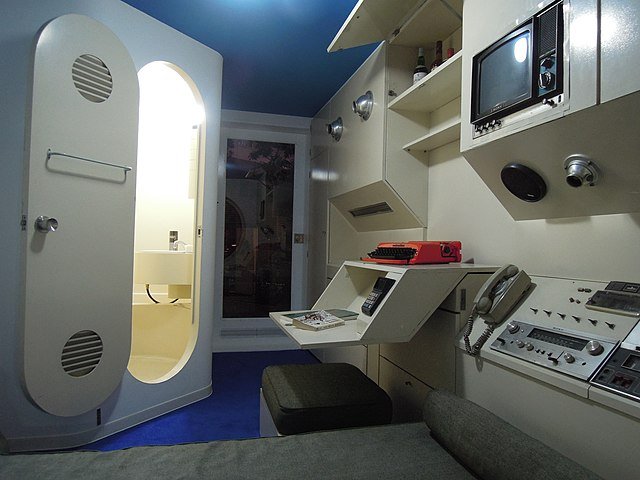A Look at Living Buildings: The Mid Century Metabolism Movement in Interior Design History
Nakagin Capsule Tower Inteiror | Photo by Dick Thomas Johnson from Wikimedia Commons
This blog post contains affiliate links. For more information please visit our disclaimer page.
The mid-century metabolism movement in interior design represents a significant era that brought forth innovative concepts and design elements. During the mid-20th century, a new wave of architectural and design philosophy emerged, emphasizing functionality, sustainability, and integration with nature. This movement was characterized by its forward-thinking approach, embracing technological advancements and futuristic concepts.
Major Works of the Time
One of the most iconic works of the mid-century metabolism movement is the Nakagin Capsule Tower in Tokyo, Japan. Designed by architect Kisho Kurokawa, this residential tower features modular capsule units that can be connected and disconnected to accommodate changing space needs—a true reflection of the movement's flexibility and adaptability principles.
Nakagin Capsule Tower Exterior Architecture | Photo by Arthur Mazi on Unsplash
Capsule from Nakagin Capsule Tower Building | Photo by Kestrel from Wikimedia Commons
Arrangement for Nakgin Capsule Tower of a typical floor | Graphic by Mliu92 from Wikimedia Commons
Habitat 67, located in Montreal, Canada, is another iconic residential complex renowned for its groundbreaking architectural design. Designed by architect Moshe Safdie for the World Exposition of 1967, Habitat 67 is a striking amalgamation of modular concrete forms that create a unique stacked structure. The complex consists of 354 identical, prefabricated concrete units arranged in various combinations to form 146 residences.
The interior design of Habitat 67 is characterized by an innovative use of space, with interconnected rooms and split-level layouts that maximize natural light and provide stunning views of the surrounding landscape. Overall, Habitat 67 stands as a visionary example of modernist architecture and continues to inspire architects and designers around the world.
Habitat ‘67 exterior architecture | Photo by Green Prophet on Unsplash
Habitat ‘67 interior | Photo by Dee Em from Wikimedia Commons
Another notable work is the TWA Flight Center at JFK Airport in New York, designed by Eero Saarinen. This futuristic building exemplifies the movement's emphasis on organic forms and innovative use of materials. With its sweeping curves and modernist aesthetic, the TWA Flight Center remains a timeless symbol of mid-century design.
TWA Flight Center at JFK Airport | Photo by Acroterion from Wikimedia Commons
Main floor plan of the Trans World Airlines Flight Center at JFK International Airport | Created by Beyer Blinder Belle Architects and Planners from Wikimedia Commons
Major Design Elements
Key design elements that were central to the mid-century metabolism movement include:
Open Floor Plans: Spaces were designed to flow seamlessly from one area to another, promoting connectivity and a sense of openness.
Natural Light: Large windows, skylights, and glass walls were incorporated to bring abundant natural light into interiors, blurring the boundaries between indoor and outdoor spaces.
Integration with Nature: The movement emphasized harmonizing architecture with the surrounding environment, incorporating elements like indoor gardens and green roofs.
Modularity: Furniture and architectural components were often modular in design, allowing for flexibility and easy reconfiguration of spaces.
Innovative Materials: Designers experimented with new materials such as concrete, steel, and glass, pushing the boundaries of traditional construction methods.
Minimalism: Clean lines, geometric shapes, and simple forms characterized the minimalist aesthetic of mid-century metabolism design.
The mid-century metabolism movement in interior design stands as a testament to the era's progressive approach to architecture and aesthetics. By embracing technology, functionality, and sustainability, designers of this period created spaces that were not only visually stunning but also deeply connected to the evolving needs of society. Today, the influence of the movement can still be seen in contemporary design trends, showcasing its enduring relevance and impact on the world of interior design.
READ MORE ON THE METABOLISM MOVEMENT:
1) Project Japan: Metabolism Talks... | 2) The Metabolist Imagination: Visions of the City in Postwar Japanese Architecture and Science Fiction | 3) Moshe Safdie: Beyond Habitat | 4) Kenzo Tange and the Metabolist Movement: Urban Utopias of Modern Japan | 5) Beyond metabolism: The new Japanese architecture (A McGraw-Hill publication) | 6) Moshe Safdie. Habitat '67, Montreal
MORE DESIGN THROUGH TIME:















